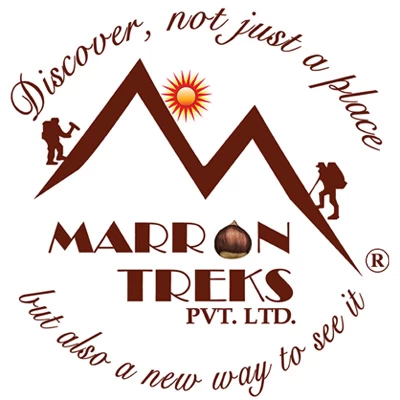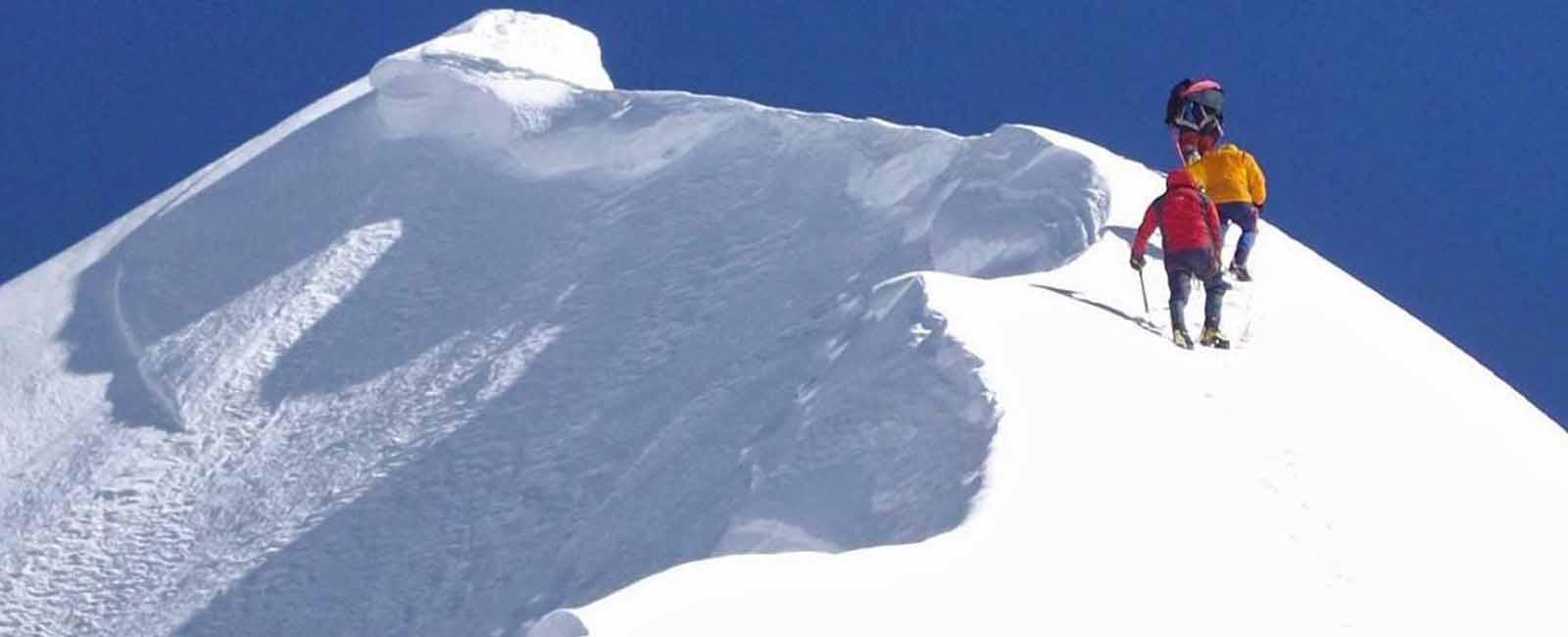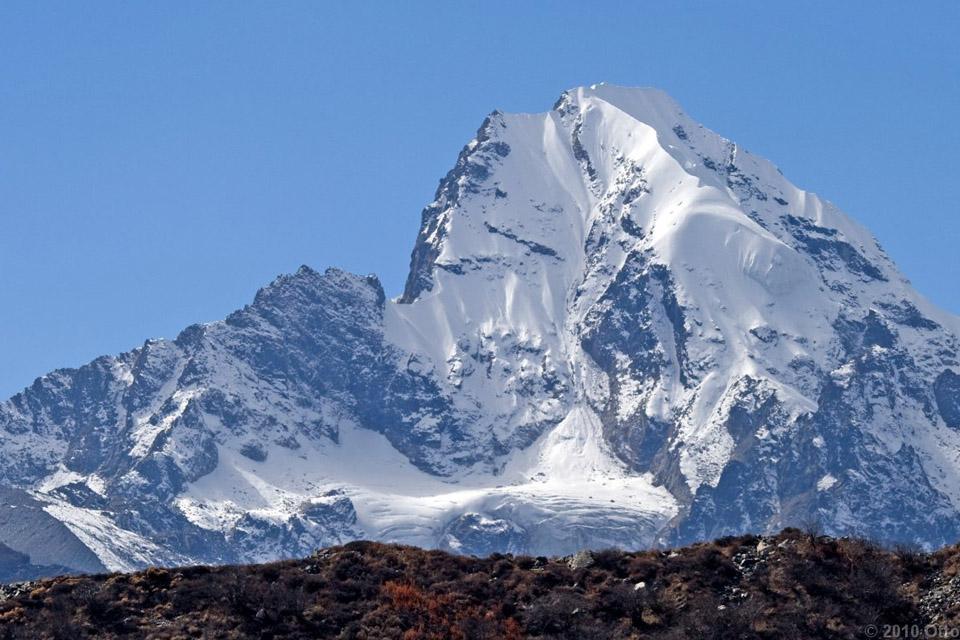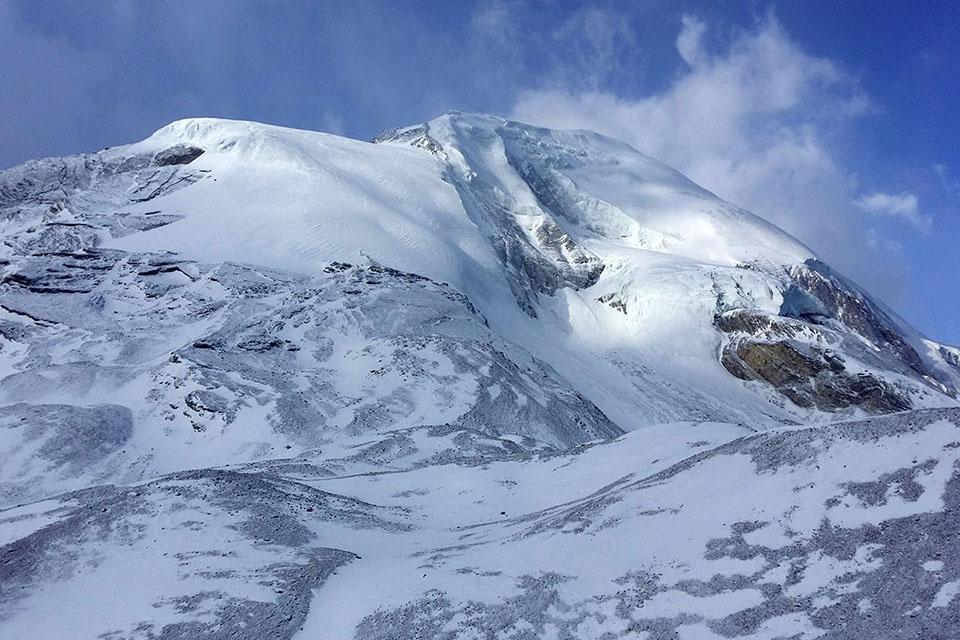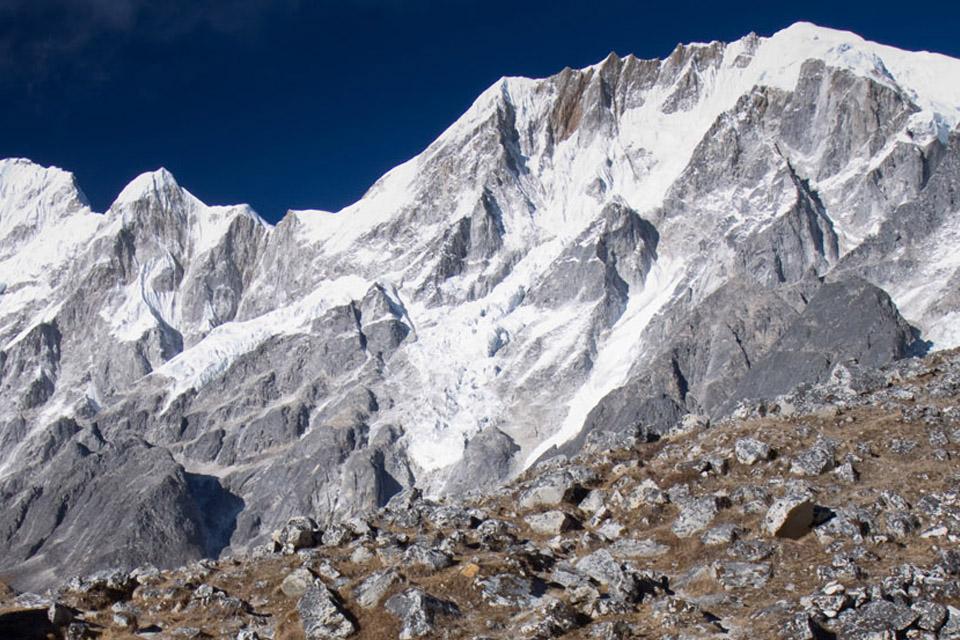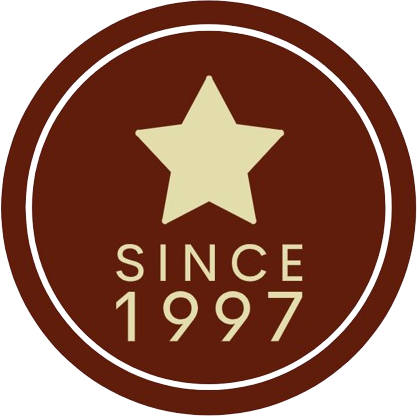Chulu East Peak climbing
Trip at a Glance
Chulu East Peak climbing is a popular mountaineering expedition in the Annapurna region of Nepal. Chulu East is a mountain peak with an elevation of 6,584 meters (21,601 feet) and is considered technically challenging requiring previous alpine experience and familiarity with basic mountaineering skills. The Expedition offers a thrilling adventure in the heart of the Himalayas.
The Annapurna and Dhaulagiri mountain ranges can be spotted in stunning panoramic views from the summit. With the approach to base camp from the town of Manang, the climb is coupled with the traditional Annapurna Circuit Trek. Because of the generally more steady weather, the best seasons to climb Chulu East Peak are spring (March to May) and fall (September to November).
Prior high-altitude trekking experience and a basic understanding of mountaineering are prerequisites for climbers. For safety, it is obligatory to choose trained and experienced climbing guides. It is crucial to have the proper mountaineering equipment, such as ropes, crampons, ice axes, and warm clothes. Because of the high elevation one attends during the trek and climb, proper acclimatization is essential.
Along with Chulu West and Chulu Far East, Chulu East is a component of the Chulu range.
The Northeast Ridge is the typical climbing route. For climbers wishing to put their skills to the test in Nepal's breathtaking Himalayan scenery, Chulu East Peak provides a challenging and rewarding mountaineering adventure.
Chulu East Peak climbing Highlights:
- Ideal combination of climbing & trekking with the traditional Annapurna Circuit Trekking
- A trekking peak that is among the highest in Nepal, approved by the Nepal Mountaineering Association (NMA)
- A great summit to validate your alpine skills
- Views of Mt. Annapurna II, III, and IV, Gangapurna, Glacier Dome, Dhaulagiri, Tilicho Peak, Manaslu, and other nearby snow-capped peaks are unreal.
- Visit Muktnath (3850m), a popular destination for pilgrims who practice Buddhism and Hinduism
Chulu east peak climbing difficulty
A mix of technical skill, mental preparedness, and physical fitness are required for the challenging task of climbing Chulu East Peak. There are technical sections of the climb that call for climbing expertise. This includes using tools like crampons, ice axes, and ropes; traversing steep snow and ice slopes; and traveling on glaciers.
Over the course of several days, the trip calls for constant physical effort. Climbers need to be ready to hike and climb in challenging terrain for extended periods of time. In addition, the weather in the mountains is unpredictable and subject to sudden changes. Extreme cold, high winds, and possible snowfall are all things climbers need to be ready for. There are steep snow and ice slopes, glacial regions, and rocky parts among the varied terrain.
There is a considerable risk of altitude sickness at 6,584 meters (21,601 feet). Acclimatization must be done correctly. Physical activity is much more difficult at this elevation due to the lower oxygen levels.
Chulu East Peak is regarded as a challenging and technical climb. A high level of physical fitness and previous mountaineering expertise are prerequisites. A successful climb requires the right equipment, experienced guides, and proper acclimatization.
Best season for Chulu East Peak climbing
Spring and autumn are the ideal times of year to climb Chulu East Peak in Nepal. More stable weather patterns are in the spring and fall, which lowers the chance of storms and significant snowfall. Clear skies offer stunning views and superior visibility for navigation.
Temperature: Trekking and climbing are more comfortable in moderate temperatures.
Spring (March to May)
With milder temperatures and clearer skies, this season brings more stable weather. Because of the favorable weather, it's a popular time of year to climb in the Himalayas.
The hiking sections of the trek are also made quite lovely by the spring bloom.
Autumn (September to November)
With sunny skies and dry weather following the end of the monsoon season, autumn is another great season for climbing. There are spectacular views of the surrounding mountains thanks to the clear air and good visibility. The cooler temperatures is perfect for the strenuous activity of climbing.
Monsoon (June to August) is to be avoided for the climb, where trails become muddy and risky after heavy rains. Views of mountains are frequently obscured by clouds and there will be a higher chance of landslides.
Winter (December to February) is also not favorable where climbing is extremely difficult and risky due to extremely cold weather and a lot of snowfall. There can be a large number of teahouses and support services closed.
Chulu East vs. Chulu West Peak
It's important to know that despite called as Chulu East and Chulu West Peaks, both peaks share the same massif but provide different climbing experiences.
Chulu East, at 6,584 meters (21,601 ft), is slightly higher than Chulu West. Most climbers agree that the climb is not as technically challenging as Chulu West. In comparison to Chulu west, the climb may be seen as easier in terms of the technical aspects of the route itself, despite the steep sections and glacier navigation. However, prior high-altitude mountaineering experience is still required.
At 6,419 meters, Chulu West is a slightly lower (21,06). It is often seen as being more technically difficult. Steeper parts, more complicated glacier travel, and more difficult terrain are all possible on this route. Climbers with more expertise and advanced mountaineering skills are better suited for Chulu West. Chulu West is the most technically challenging of the two.
Chulu East Peak climbing permit cost
Chulu East Peak climbing requires trekking in the Annapurna region protected under the Annapurna Conservation Area Project (ACAP). Thus entrance fee for ACAP including peak permit for Chulu East and Trekking Information Management System (TIMS) card is required.
Chulu East Peak peak climbing permits price
1) ACAP permit fee for foreigners: NPR 3,000 (Approx. USD22)
2) Trekking Information Management System (TIMS) card permit: NPR 2000 (Approx. USD15)
3) Royalty for Foreign climbers for Chulu East Peak (per person in US dollar)
Spring (March-April-May) USD400
Autumn (Sept-Oct-Nov) USD200
Winter (Dec-Jan-Feb) USD100
Summer June-July-Aug) USD100
4) Garbage deposit USD500 (Refundable)
Itinerary
Day 01: Arrival in Kathmandu (1400m)
Day 02: In Kathmandu - Climb preparation
Day 03: Drive to Besisahar by private vehicle & change local jeep to Dharapani (1,860m/10-11 hrs)
Day 04: Trek from Dharapani to Chame (2,650 m/5-6 hrs)
Day 05: Trek from Chame to Pisang (3,250 m/5-6 hrs)
Day 06: Trek from Pisang to Manang (3,519 m/5-6 hrs)
Day 07: Acclimatization day at Manang (3,519 m)
Day 08: Trek from Manang to Yak Karka (4000 m/3-4 hrs)
Day 09: Trek from Yak Kharka to Chulu East Peak Base Camp (5140m/4-5 hrs)
Day 10: Base Camp to summit (6584m)& back to base camp (5140m/8-9 hrs)
Day 11: Trek from Base Camp to Ledar (4,210m/5-6 hrs)
Day 12: Trek from Ledar to Throng Phedi (5,416m/3-4 hrs)
Day 13: Trek from Throng Phedi to Muktinath via Throng La (5,416m/9 hrs)
Day 14: Trek from Muktinath to Jomsom (3,760m/5-6 hrs)
Day 15: Fly from Jomsom to Pokhara (820m/20 minutes)
Day 16: Flight or drive from Pokhara to Kathmandu (1400m/25min)
Day 17: Final Departure
Once you land at the Tribhuwan International Airport in Kathmandu and accomplish your entry/visa formalities, you will be received by a representative from Marron Treks and transferred to the hotel. Welcome drinks will be served at the hotel after which we will have a quick pre-trip meeting and discuss the itineraries. You can then take your time to relax, unpack and spend the time as you wish. In the evening, stroll around the nearby places and get the feel of this energetic city.
Today is a climb preparation day for equipment/gear check, shopping or renting for personal climbing gear.
Early in the morning, take a long but scenic journey from Kathmandu to Dharapani via Besisahar. The route takes you through lush green hills, rivers, and traditional villages, gradually transitioning from paved roads to off-road terrain. The journey offers stunning views of the Trishuli and Marshyangdi rivers before reaching the starting point of the Annapurna Circuit trek.
We have breakfast today and then resume our hike. We will climb up to the settlement of Chame by navigating via a couple steep forested ridges and other landslide locations. But we shouldn't overlook raising our gaze, as the spectacular views of Lamjung Himal, Annapurna II, and Annapurna IV (7,525m) await us. We also find a few little hot springs, which should provide us with some temporary relaxation.
After breakfast today, we will travel through an extremely deep forest before arriving at the striking curved rock face that rises 1500 meters above the river valley. We will arrive to Bhratang Village, well-known for its apple orchards. After that, we go up a rocky trail through the Marshyangdi Valley to Paungda Danda, which is a gigantic rock face that slopes upward nearly 5,000 feet (1,500 meters) above the trail. Once you get past this final section of rock, Dhukur Pokhari offers breathtaking views across the valley. We hike for a long from here until we get in Pisang, where we spend the night.
You will take the upper trails which pass through Upper Pisang and Geru to reach the village of Barge. Barge village is popular for the Barge Monastery – the biggest in Manang. Along the trail you will come across several Buddhist shrines and monasteries and finally reaches the big town of Manang. The trekking trail provides fantastic views of Annapurna II, III, IV, Gangapurna, Pisang Peak, and Tilicho.
Today is rest day at Manang for better acclimatization to adjust with the increasing altitude and to avoid altitude sickness. You can rest at your lodge or explore around Manang town visiting nearby interesting places like Gangapurna and Ice lakes, the traditional Kangsar village, and Milarepa Cave – believed to be the meditation bode of Buddhist Guru Milarepa. Visiting Vraja village will take you to Himalayan Rescue Association where you will learn more about acute mountain sickness.
With better acclimatized in Manang the trek continues to Yak Kharka. Now the trail with tall trees changes to alpine grass and junipers. You might notice a few horses or yaks grazing on the meadows en route. Walking further will reach the small village of Gunsan which has flat mud roof houses. After crossing a small river on a wooden bridge will give you a hint that Yak Kharka is nearby which is a peaceful meadow – is nearby.
Today, you will trek from Yak Kharka (4,020m) to Chulu East Peak Base Camp (5,140m), gaining over 1,100 meters in altitude. The trail is steep and rugged, with stunning views of the Annapurna range, Chulu peaks, and the Marsyangdi Valley. Since you will be trekking above 5,000m, altitude adaptation is crucial, so maintaining a steady pace and staying hydrated is essential.
Today is the most challenging and rewarding day of your expedition—summiting Chulu East Peak (6,584m). The ascent involves steep snow slopes, icy ridges, and technical sections requiring ropework, crampons, and ice axes. You will begin the climb before dawn to take advantage of stable weather conditions and return to Base Camp safely before late afternoon. From the summit, you are surrounded by snow-capped peaks, deep valleys, and glaciers
After the exhausting yet rewarding summit of Chulu East (6,584m), today’s trek involves descending back to Ledar (4,210m). The journey takes around 5-6 hours, gradually losing altitude and giving your body time to recover. The trail retraces back through moraine ridges, rocky paths, and alpine pastures, with magnificent views of the Annapurna range, Marsyangdi Valley, and Chulu peaks.
Today’s trek is relatively short but crucial for acclimatization before crossing Thorong La Pass (5,416m) the next day. You will ascend 330m over rocky, landslide-prone trails, following the Marsyangdi River and passing through Yak pastures. The landscapes are dry, barren, and rugged, with stunning views of Annapurna III, Gangapurna, and the Thorong Peak ranges.
This day is the most challenging day of the entire trek which involves crossing Thorong La High Pass which is one of the highest passes in the world. You will ascend up to Thorong La then descend down to Muktinath. Afternoon will be too windy to cross the pass so you will start early morning battling icy air and high altitude but still enjoying the views. Upon reaching the top of the pass witness even great views of peaks like Khatungkang, Gangapurna, and Annapurna ranges.
After enjoying a great photographic moments you will descend to Muktinath enjoying another good view of Dhaulagiri. With continue descending will reach Muktinath temple. It’s the holy temple for both Hindus and Buddhists which has 108 water spouts and an eternal flame which is burning there for ages. Stay overnight at Muktinath.
Today is the last day of trekking and the route heads down the valley loosing elevation and gradually rejoining the Kali Gandaki River Valley bottom to reach Jomsom. Upon reaching Jomsom you may feel like a big change from the serene trails and villages which you passed during the trek. Rest and explore around in Jomsom town.
Take the early morning flight to Pokhara from Jomsom which is a short flight of about 35 minutes. Upon reaching Pokhara the rest of the time is rest at your hotel or explore the beautiful lakeside city of Pokhara. In the evening you can visit the lakeside area closer to Phewa Lake with many restaurants, pubs, eateries which is like the tourist hub of Thamel in Kathmandu.
After breakfast you can either choose to fly to Kathmandu from Pokhara (20 minutes) or take an overland drive to Kathmandu (6-7 hours drive). Upon reaching Kathmandu check-in hotel and the evening is all set for Farewell Dinner at one of the authentic Nepali restaurants.
The trip concludes and our office representatives will take you to the international airport in Kathmandu to catch your onward flight to your next destination or fly back home. You need to be at least 3 hours prior to your flight time at the airport.
Thank you for visiting Nepal and we hope your Himalayan Holiday has come true. Have a safe flight back home!
What is included?
- Airport pick-up and drop services.
- Hotel accommodations in Kathmandu & Pokhara with breakfast as per itinerary.
- Kathmandu to Dharapani drive by local bus/jeep or private vehicle.
- All trekking accommodations with Breakfast/Lunch/Dinner at local lodges & tents on twin sharing basis.
- Experienced government-licensed climbing guide & porters (1 porter for two people) including their food, accommodation, & salary.
- Four seasonal sleeping bags and duffel bags (to be returned after trip completion)
- A comprehensive medical kit (will be carried by the trekking guide)
- Group climbing gear like climbing rope, ice screws, snow bars etc.
- All camping equipment required during the climb (sleeping tents/mattresses, kitchen tent, kitchen equipment).
- Personal insurance for climbing/trek crew.
- Jomsom/Pokhara airfare
- Annapurna Conservation entry permit & TIMS Card.
- Chulu East Peak Climbing Permit.
- Pokhara/Kathmandu transfers by a tourist bus or private vehicle (Option: Flight)
- Farewell dinner with Nepalese cultural program.
- All government and local taxes.
What is not included?
- International airfares.
- Nepal entry visa fee – Visa can be obtained upon your arrival at the Tribhuwan International Airport in Kathmandu. (USD30 for 15 days)
- Lunch & dinner in Kathmandu or Pokhara.
- Personal travel insurance.
- Emergency rescue evacuation (to be covered by the client's travel insurance).
- Other expenses of a personal nature (phone calls, laundry, battery recharge, extra porters, bottle or boiled water, hot shower etc.)
- Personal climbing gear
- Bar bills, alcoholic drinks & beverages.
- Garbage deposit fees (refundable).
- Tips for guide & porter.
Route Map
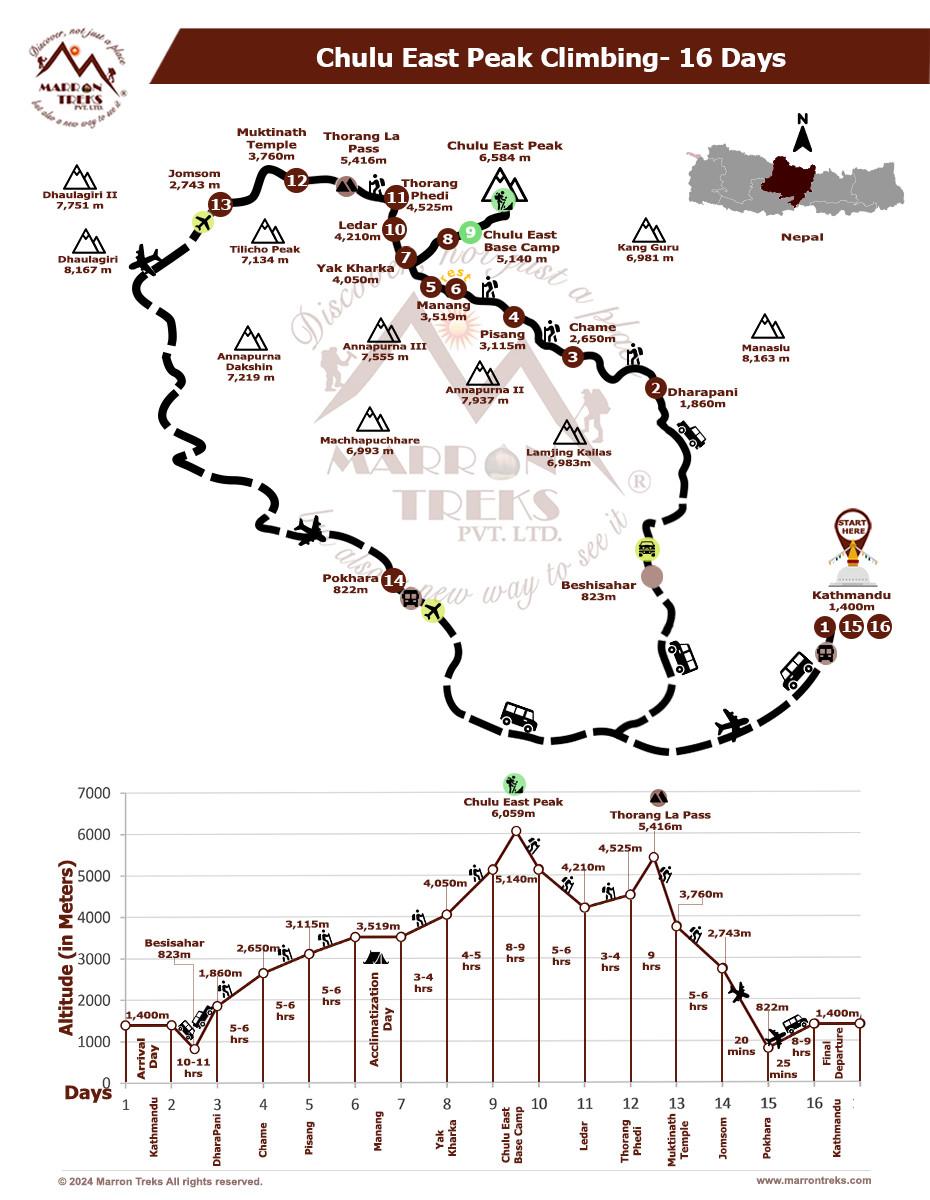
Trip Info
Accommodation
While you are in Kathmandu, we opt to accommodate you in 4- or 5-star hotels like Hotel Royal Singhi (4-star), Hotel Manaslu (4-star), Radisson (5-star), Yak & Yeti (5-star), or similar. During the trek, you will be accommodated in a local mountain lodge, better known as Tea House. These lodges and teahouses provide good services and are equipped with basic amenities. We will endeavor to provide you with the best accommodation available along the route so that you get a good night’s rest in a hygienic milieu.
Meals
We never compromise the quality of food or the health of the trekkers as well as the crew members. Generally, we opt for the fresh and nutritional local community food available. You could make your delicious pick from an array of traditional foods like Sweet potatoes, buckwheat barley, etc. This way, you could not only get a real sense of the local culture and life patterns but also contribute to promoting the locally available resources of organic food and beverages. Besides, a wide range of Continental, Chinese, Italian and Indian cuisines like Pizza, Spaghetti, French Fries, Soups, Breads, Masala curry, etc. are also available in the restaurants for your retreat.
Acclimatization
Altitude sickness is a serious risk while trekking in the Himalayas. It's important to acclimatize properly by spending a few days at lower altitudes before heading higher. By spending time at lower altitudes before pushing higher, your body has time to adjust. Our trekking packages have enough acclimatization days planned where you'll be spending a day or two at lower altitudes, allowing your body to adjust to the increasing altitude.
Electricity & drinking water
For an additional cost, you can use the electricity in all tea houses and lodges to recharge your batteries. The lodges have packaged mineral water for sale, or you can fill your bottle with boiling water. To make water drinkable, you can use water purification tablets too. But, due to hygienic issues, you should avoid drinking water from taps, rivers, or wells in trekking areas.
Communication
At lodges, restaurants, and hotels, Wi-Fi is available for an additional fee in the most popular trek regions, like Everest, and Annapurna. However, at high elevations, phone calls are the only means of connection. Our office in Kathmandu is in constant communication with your trek guide. In Kathmandu, you can purchase a local sim card for communication purposes. At high elevations, the mobile signal might not be as strong, though.
Luggage
Our porters are paired with one trekker for every two hikers, and one porter can safely carry 30 kg maximum weight. Therefore, we advise you to fill your duffle bag not more than 15 kg with your belongings. You may carry a small backpack with your valuables and informational documents. The things you are not taking along on the trek can be stored in a hotel in Kathmandu free of cost.
Typical Trek Day
Mostly your trek day starts with breakfast at 7-8 am, followed by a 3-4 hour morning trek. Lunch break is around an hour, then you continue trekking to your destination for the day. After reaching the teahouse lodge, you can relax, explore nearby areas, and enjoy dinner at 6-7 pm. Evenings involve socializing, a trek briefing, and leisure activities before bed.
Travel Insurance
It is advised that you arrange your travel insurance before leaving your homeland. The main thing is to make sure that your insurance covers you for both- medical and evacuation costs. Having travel insurance with you makes your trip secure and hassle-free.
Our Guides
Guides play a significant role during the trek. They are the ones who literally decipher the trekking codes for you so that you can actually connect with nature, culture and people along the way. We have helpful and dedicated trekking guides who are very well-versed in the culture, life patterns and every single detail pertaining to the trek region you are traveling in. Thus, in the company of our professional Sherpa guides, your trek becomes not only entertaining but also equally informative.
Porter and Staff Care
When it comes to high-altitude trekking, porters and staff members make up a pivot. Marron Treks ensures that all the porters and staff members going to high altitudes are provided with adequate clothing and equipment. All our field staff are covered by insurance.
